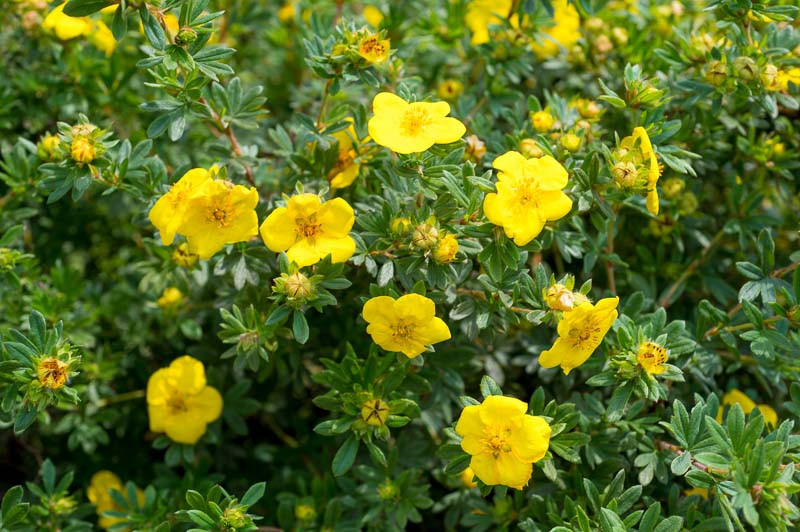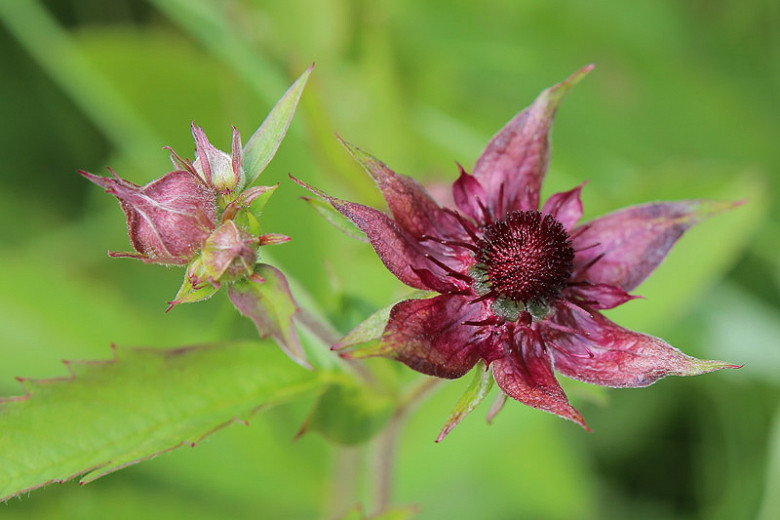Potentilla: The Versatile Flower That Blooms
Potentilla is a genus of flowering plants in the rose family, Rosaceae. There are over 500 species of potentilla, found in temperate and cold regions around the world. Potentillas are known for their daisy-like flowers, which can be yellow, white, pink, orange, or red. They are also known for their tough, hardy nature. Potentillas can tolerate a wide range of conditions, including drought, poor soil, and full sun.
One of the most popular species of potentilla is shrubby cinquefoil (Potentilla fruticosa). Shrubby cinquefoil is a small-to-medium-sized deciduous shrub that can grow up to 3 feet tall. It has bright yellow flowers that bloom in the spring and summer. Shrubby cinquefoil is a versatile plant that can be used in a variety of landscape settings. It is a good choice for borders, rock gardens, and foundation plantings. It is also deer-resistant, making it a good choice for gardens in areas with high deer populations.
Another popular species of potentilla is creeping cinquefoil (Potentilla reptans). Creeping cinquefoil is a low-growing perennial that can spread to form a groundcover. It has small yellow flowers that bloom in the spring and summer. Creeping cinquefoil is a good choice for shady areas and can be used to suppress weeds. It is also drought-tolerant and deer-resistant.
Potentillas are easy to care for. They need full sun or partial shade and well-drained soil. They are drought-tolerant once established, but they will benefit from regular watering during the first year after planting. Potentillas do not need to be fertilized often, but a light application of fertilizer in the spring will help them to bloom more profusely.
Potentillas are relatively pest- and disease-free. The most common problem that they face is powdery mildew, which can be treated with a fungicide. Potentillas can also be susceptible to deer browsing, so it is important to plant them in areas where deer are not a problem.
Potentillas are a beautiful and versatile addition to any garden. They are easy to care for and can tolerate a wide range of conditions. Whether you are looking for a colorful shrub or a low-growing groundcover, there is a potentilla that is perfect for your garden.
Potentilla is a genus of flowering plants that includes over 300 species. It is also known by the common names cinquefoil, five fingers, and silverweed. Potentillas are found in a variety of habitats, including meadows, forests, and roadsides. They are typically herbaceous plants, but some species are shrubs or even trees. Potentillas have yellow, pink, or white flowers. The leaves are typically compound and have five leaflets.
Potentillas are used for a variety of purposes, including ornamental gardening, medicinal use, and food. Some species of potentilla are edible, and the leaves and flowers of others can be used to make tea. Potentillas are also used in traditional medicine to treat a variety of ailments, including stomach upset, inflammation, and wounds.
To learn more about potentilla, please visit Home Gardening.
FAQ of potentilla
- What is potentilla?
- Potentilla is a genus of flowering plants in the rose family (Rosaceae). There are over 500 species of potentilla, which are found in a variety of habitats, including meadows, forests, and roadsides.
- What are the special features of potentilla?
- Potentilla plants are known for their daisy-like flowers, which come in a variety of colors, including yellow, pink, white, and orange. They also have compound leaves, which are made up of several leaflets.
- What are the best conditions for potentilla?
- Potentilla plants prefer well-drained soil and full sun. They can tolerate a variety of soil pH levels, but they will do best in slightly acidic soil.
- How to grow potentilla?
- Potentilla plants are easy to grow from seed or by dividing existing plants. They can be planted in the spring or fall. When planting, make sure to amend the soil with compost or manure. Water regularly, especially during the first year of growth.
- How to care for potentilla?
- Potentilla plants are relatively low-maintenance. They only need to be watered during dry periods and fertilized once a year in the spring. They may need to be pruned in the spring to remove dead or damaged growth.
- What are the common pests and diseases of potentilla?
- Potentilla plants are susceptible to a few pests and diseases, including aphids, spider mites, and powdery mildew. These problems can usually be controlled with insecticidal soap or neem oil.
- Is potentilla poisonous?
- No, potentilla plants are not poisonous. They are actually edible and have been used for medicinal purposes for centuries.
Image of potentilla
10 different images of potentilla that are free to use:
- Potentilla fruticosa, commonly known as creeping cinquefoil, is a low-growing shrub with yellow flowers.

- Potentilla erecta, commonly known as upright cinquefoil, is a taller shrub with white flowers.
- Potentilla anserina, commonly known as silverweed, is a spreading plant with white flowers.

- Potentilla fragarioides, commonly known as strawberry cinquefoil, is a plant with white flowers that have a strawberry-like scent.
- Potentilla palustris, commonly known as marsh cinquefoil, is a plant with yellow flowers that grows in wet areas.

- Potentilla pensylvanica, commonly known as Pennsylvanian cinquefoil, is a plant with yellow flowers that grows in North America.
- Potentilla recta, commonly known as upright potentilla, is a plant with yellow flowers that grows in Europe.

- Potentilla tridentata, commonly known as three-toothed cinquefoil, is a plant with yellow flowers that grows in North America.

- Potentilla verna, commonly known as spring cinquefoil, is a plant with yellow flowers that grows in Europe.

- Potentilla wilmottiana, commonly known as Wilmott's cinquefoil, is a plant with yellow flowers that grows in Asia.
/Cinquefoil(Creeping)_2015_06_23_Warrington_MooreReserve_097p3.jpg)
Post a Comment for "Potentilla: The Versatile Flower That Blooms"